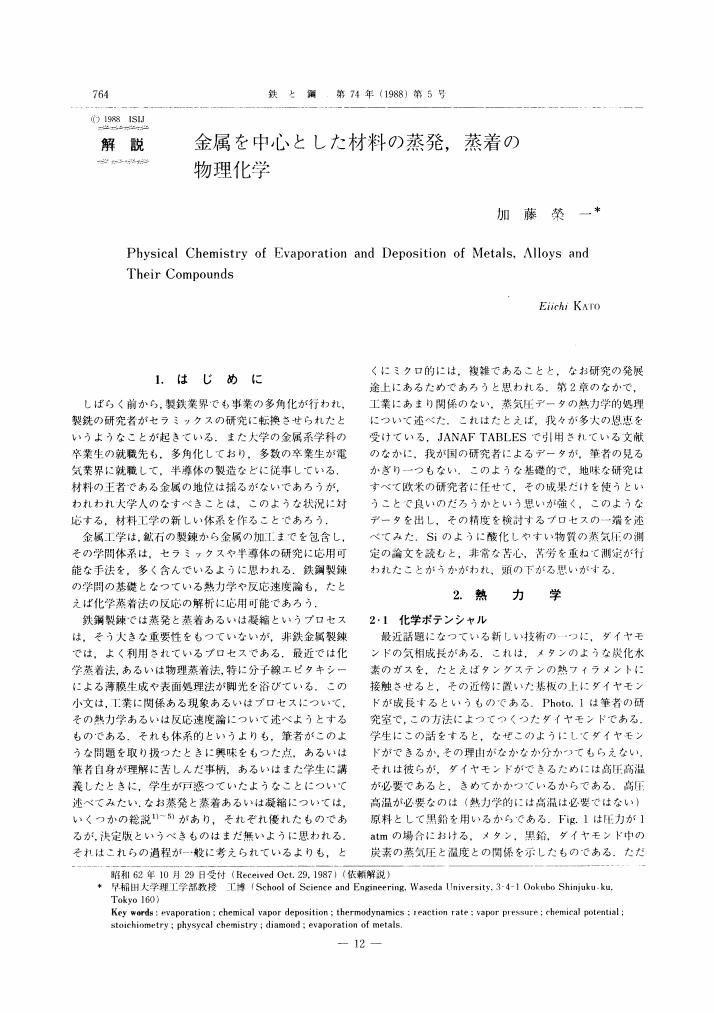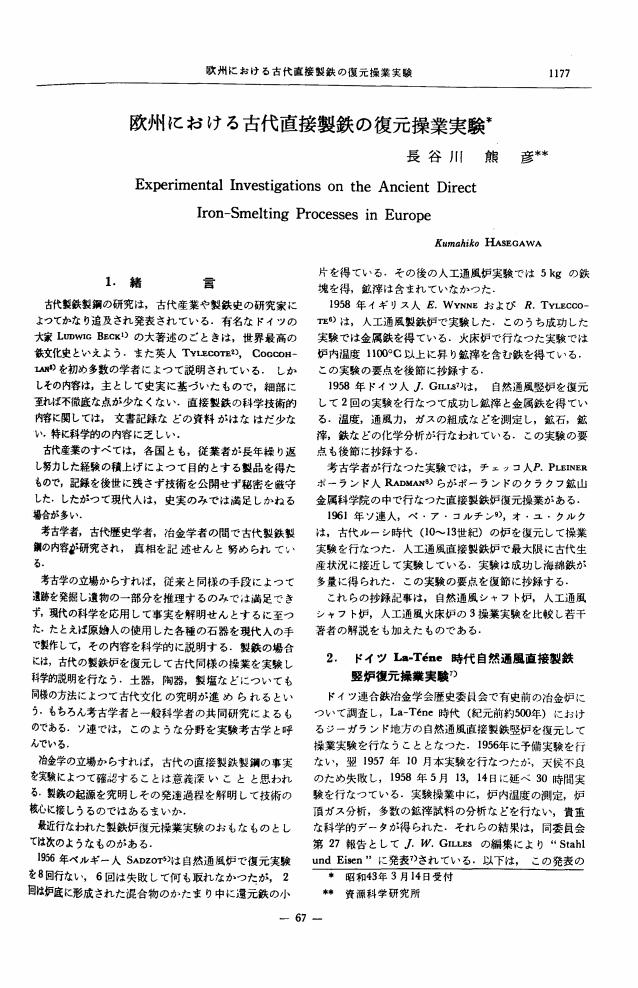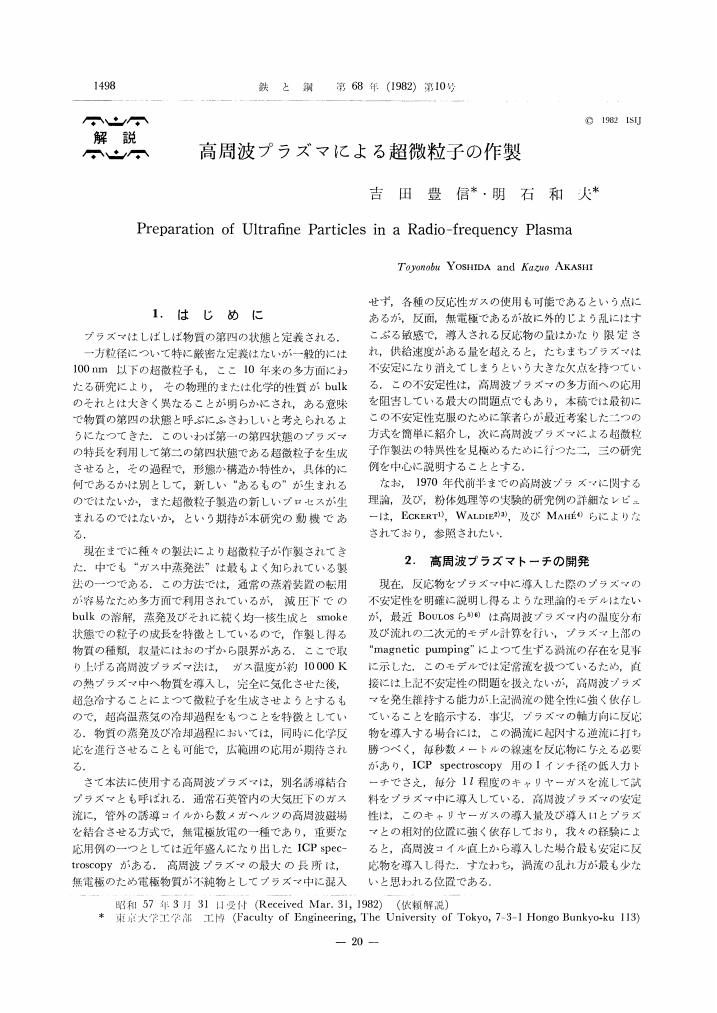2 0 0 0 OA ピアノ線製造法に関する研究
- 著者
- 虎岩 頼夫
- 出版者
- The Iron and Steel Institute of Japan
- 雑誌
- 鐵と鋼 (ISSN:00211575)
- 巻号頁・発行日
- vol.29, no.7, pp.614-618, 1943-07-25 (Released:2009-07-09)
The author has experimentally manufactured various kinds of piano wire since Showa 15 (1940) from the necessity of the domestic manufacture of piano wire. In the present report, some properties of different kinds of domestic wire were compared with the imported products. It was confirmed that the quality as good as the imported products are now available in the wholly domestic wire, although more efforts are expected for the manufacture of better qualities. Above all, he mentioned of the brittleness appearing in the low-temperature heating and laid stress on its preventive methods. As the fundamental data, the result of the test on the effect of drawing speed, was described with special reference to the prospect of the X-ray study necessary therefor.
2 0 0 0 OA 連続溶融亜鉛メッキにおけるドロス生成反応について
- 著者
- 山口 洋 久松 敬弘
- 出版者
- The Iron and Steel Institute of Japan
- 雑誌
- 鉄と鋼 (ISSN:00211575)
- 巻号頁・発行日
- vol.60, no.1, pp.96-103, 1974-01-01 (Released:2010-10-12)
- 参考文献数
- 12
- 被引用文献数
- 13 13
A study has been carried out on the dross formation in continuous galvanizing in relation to the aluminiumcontent in the bath.Iron and aluminium concentrations in drosses formed in conventional galvanizing lines are determined.In the laboratory, Zn alloys containing 0.22% Pb, 0.13-4.60% Al and 0.066-0.24% Fe are molten ingraphite crucibles and held at 465°C for 40hrs before cooling. Using the sectioned ingots, spectroscopic analysisof the portions free from dross and quantitative microscopy analysis of dross compounds are performed:On the basis of these results, the amount of dross and that of aluminium consumed in the dross formationreaction in conventional processes are estimated. Conclusions derived are as follows:Drosses contain two compounds, namely δ and Fe2Al5.When the aluminium content in the bath is in the range of 0.09-0.14%, δ and Fe2Al5 can coexist. Inthis case the higher the aluminium content, the lower the fraction of δ-compound. When the aluminiumcontent is higher than 0.15% the δ-compound can not be found.The amount of the bottom dross is estimated to decrease rapidly with increasing the aluminium contentin the bath up to 0.14% and becomes negligible above 0.15% Al. The amount of the top dross, however, increasesrapidly with increasing the aluminium content up to 0.14% and decreases gradually above 0.15% Al.The amount of aluminium consumed in the dross formation reaction is estimated proportional to the amount of iron dissolved from sheets.
2 0 0 0 OA 鋼の表面硬化法としての窒化
- 著者
- 高瀬 孝夫
- 出版者
- The Iron and Steel Institute of Japan
- 雑誌
- 鉄と鋼 (ISSN:00211575)
- 巻号頁・発行日
- vol.66, no.9, pp.1423-1434, 1980-08-01 (Released:2009-06-19)
- 参考文献数
- 48
- 被引用文献数
- 10 16
2 0 0 0 OA ソ連及び中共の小型ベツセマー製鋼法
- 著者
- 福島 政治
- 出版者
- The Iron and Steel Institute of Japan
- 雑誌
- 鐵と鋼 (ISSN:00211575)
- 巻号頁・発行日
- vol.40, no.12, pp.1128-1142, 1954-12-25 (Released:2009-07-09)
Side-blown baby-bessemer converters are employed in foundries for the production of steel castings, in U.S.S.R. recently, however, a large number of this type of converters are also used for the production of steel ingots under a new name of "Soviet Union's Process." And also, they assert that steel made by the side-blown converters have lower gas content and higher resistance to the low-temperature shortness than the others made by the open hearth furnace. The distinctive point of this new process is to use the over-heated low-Si molten pig iron (0.3-0.5% Si, 1400-1450°C) in the converter. Therefore, it seems to be nearly identical with the old Swedish process, but they maintain that it is their own process.Normally, in the baby-bessemer process, or in the high-or medium-Si process, they refine hematite pig iron, which is usually melted in usual cupolas. In works producing steel ingots by this new process, however, the cupolas are of a special design and the charge employed contains high percentages of steel scrap (90-95%), which is partially recarburized before blowing in the converter.From the results of several practical studies on the high Si Process (>1.6% Si), the medium Si process (1.1-1.6% Si), the low-Si process (<1.0% Si) and this new process by a 1.5t converter in each, merits of this new process were pointed out as follows;a) The shortening of the blowing time.b) The lessening of the blowing-loss of molten metal.c) The increasing of the steel scrap in the raw material of cupola.In the Chinese communist region, lately, in some works this type of converters are also used for the production of steel ingots, and they are blowing the comparatively lower Si molten pig iron (0.8-1.2% Si, 1300-1350°C) in the converter. It may be said that, from the great demand of steels in that region, this simple process will be developed more and more in future.
2 0 0 0 OA 傾注式百瓲平爐に於ける鑛石法に就て
- 著者
- 蜂谷 茂雄
- 出版者
- The Iron and Steel Institute of Japan
- 雑誌
- 鐵と鋼 (ISSN:00211575)
- 巻号頁・発行日
- vol.28, no.6, pp.613-626, 1942-06-25 (Released:2009-07-09)
The Yawata Iron Works have intended to practise the pig-ore process in the 100ton open hearth furnace being supplemented with the mixer for preliminary smelting.However, owing to shortage of the capacity of the mixer, they are partly obliged to practise the ordinary pig-ore process by using the open hearth furnace alone. The author explained the pig-ore process by the parallel use of an open hearth furnace and a mixer, citing the actual operations with special reference to the control of slags which is necessary for the open hearth furnace smelting. Moreover, the author described the actual operation of redressing the hearth which plays the important role in improving the efficiency of the pig ore process, some points of improvement in the body of the open hearth furnace developed since beginning and informed experiences and results of using the mixed gas as fuel.
2 0 0 0 OA 航空機機体材料の開発動向
- 著者
- 伊藤 好二
- 出版者
- The Iron and Steel Institute of Japan
- 雑誌
- 鉄と鋼 (ISSN:00211575)
- 巻号頁・発行日
- vol.76, no.2, pp.137-148, 1990-02-01 (Released:2010-02-16)
- 参考文献数
- 24
2 0 0 0 OA 金属を中心とした材料の蒸発,蒸着の物理化学
- 著者
- 加藤 榮一
- 出版者
- The Iron and Steel Institute of Japan
- 雑誌
- 鉄と鋼 (ISSN:00211575)
- 巻号頁・発行日
- vol.74, no.5, pp.764-775, 1988-05-01 (Released:2009-05-29)
- 参考文献数
- 30
- 被引用文献数
- 2 3
2 0 0 0 OA 最近のバネ鋼に就て
- 著者
- 内山 道良
- 出版者
- The Iron and Steel Institute of Japan
- 雑誌
- 鐵と鋼 (ISSN:00211575)
- 巻号頁・発行日
- vol.37, no.1, pp.45-56, 1951-01-25 (Released:2009-07-09)
- 参考文献数
- 57
- 被引用文献数
- 2
Since the end of the War, spring steel has become one of the most important special steels in Japan.In 1948, the production of spring steel amount to 29, 714 tons in the total amount of special steel production of 87, 136 tons. Meanwhile the level of quality of spring in Japan, may be lower than that of in America and in Europian countries. Therefore, for general reference, the auther collected here the various recent data of spring steel, such as the history, chemical composition, mechanical property, heat treatment, mass effect, cold working etc, which will be thought to be useful for manufacturing spring and spring-steel.
2 0 0 0 OA 鹽基性鋼滓とクロムとの反應に就いて(I)
- 著者
- 齋藤 泰一
- 出版者
- The Iron and Steel Institute of Japan
- 雑誌
- 鐵と鋼 (ISSN:00211575)
- 巻号頁・発行日
- vol.35, no.4, pp.98-103, 1949-04-25 (Released:2010-01-22)
- 参考文献数
- 9
The reaction of chromium under basic, slag has been experimentally studied in laboratory furnace. In the basic slag (CaO/SiO2>2), it was found that the oxide of chromium presents as chromic-oxide, so the reaction of chromium under basic slag should be cxpressed as follow:-2[Gr]+3(FeO)_??_(Cr2O3)+3[Fe]The auther proposed as the temperature coeffcient of the equilibrium consant KBCr=(Cr2O3)/[Cr][Cr]2(FeO)3 of this reactionlog KBCr=15, 000/T-10.0
1 0 0 0 OA 本邦鑄鉄鑄鋼技術の進歩
- 著者
- 谷村 煕
- 出版者
- The Iron and Steel Institute of Japan
- 雑誌
- 鉄と鋼 (ISSN:00211575)
- 巻号頁・発行日
- vol.41, no.7, pp.770-776, 1955 (Released:2012-07-12)
- 参考文献数
- 43
A review of the iron and steel casting industry, during the past ten years, was described. The progress of the casting industry in this period has much correlation to the research activity in the pre-war and war time, therefore this review covers some details of pre-war progress.
1 0 0 0 OA 液体金属中における金属材料の腐食挙動
- 著者
- 鈴木 正
- 出版者
- The Iron and Steel Institute of Japan
- 雑誌
- 鉄と鋼 (ISSN:00211575)
- 巻号頁・発行日
- vol.75, no.11, pp.1991-2002, 1989-11-01 (Released:2009-06-19)
- 参考文献数
- 88
- 被引用文献数
- 2 1
1 0 0 0 OA 熱処理の新技術
- 著者
- 大和久 重雄
- 出版者
- The Iron and Steel Institute of Japan
- 雑誌
- 鉄と鋼 (ISSN:00211575)
- 巻号頁・発行日
- vol.56, no.3, pp.420-428, 1970-03-01 (Released:2010-10-12)
- 参考文献数
- 43
- 被引用文献数
- 1
1 0 0 0 OA 日本の古代鉄価とその国際比較
- 著者
- 新井 宏
- 出版者
- The Iron and Steel Institute of Japan
- 雑誌
- 鉄と鋼 (ISSN:00211575)
- 巻号頁・発行日
- vol.91, no.1, pp.116-121, 2005-01-01 (Released:2010-01-18)
- 参考文献数
- 24
- 被引用文献数
- 1
Nothing tells us more eloquently on the level of a technology than the cost or the quantity. If we know the prices of some metals at any period in any location, we can discuss the technical level to a certain degree only from the information. From the above idea this author is carrying out a compilation of worldwide historical metal prices and so on. In this report this author deliberates on iron prices in ancient Japan and makes an attempt to compare the prices internationally with ancient China or medieval Europe. The results are summarized as follows. (1) The ratios of iron prices for rice prices in ancient Japan are concentrated in 6 to 8 (2) The values are slightly higher than in ancient China (the ratios of iron price for rice prices are about 5), but there is no significant difference. (3) As to ancient Europe there is no appropriate document but from the 14th England case (the ratio of iron price for wheal price is 4.8) there would not be much difference. (4) The ratio of iron price for rice price is gradually decreasing worldwide and reaches 2 in 17th or 18th century.
1 0 0 0 OA 粉体力学の現状
- 著者
- 長尾 高明
- 出版者
- The Iron and Steel Institute of Japan
- 雑誌
- 鉄と鋼 (ISSN:00211575)
- 巻号頁・発行日
- vol.73, no.9, pp.1082-1088, 1987-07-01 (Released:2009-06-19)
- 参考文献数
- 23
- 被引用文献数
- 1 1
- 著者
- Hiroshi Tanii Tadahiro Inazumi Keiichi Terashima
- 出版者
- The Iron and Steel Institute of Japan
- 雑誌
- ISIJ International (ISSN:09151559)
- 巻号頁・発行日
- vol.54, no.5, pp.1044-1050, 2014-05-15 (Released:2014-06-12)
- 参考文献数
- 9
- 被引用文献数
- 7 7
This study is to investigate and clarify the details about mineralogical characteristics of iron sand used for Japanese classical iron-making furnace “Tatara”, that produces different kinds of iron product, natural steel and cast iron. Though the product difference is known experientially to be attributed to the difference of iron sand kind “Masa” and “Akome”, scientific reason is vague and their characterization is necessary. Specimen was prepared by separating the particles with the similar character by sieving and magnetic separation. Chemical analysis, XRD, mineral texture, EPMA, chromaticity and diffusive reflectance, Raman spectroscopy and specific gravity clarified that main difference between Masa and Akome is in the composition of particles mixed with different mineral characters in term of solid solution TiO2% in iron oxide and quantity of hematite that is weathered magnetite. CO gas reduction test showed that such mineral characters affect the initial temperature of reduction and mineral kinds formed on the way of reduction.
1 0 0 0 OA 欧州における古代直接製鉄の復元操業実験
- 著者
- 長谷川 熊彦
- 出版者
- The Iron and Steel Institute of Japan
- 雑誌
- 鉄と鋼 (ISSN:00211575)
- 巻号頁・発行日
- vol.54, no.11, pp.1177-1192, 1968-09-01 (Released:2010-10-12)
- 参考文献数
- 30
- 被引用文献数
- 1
- 著者
- Yasuhiko Miyoshi
- 出版者
- The Iron and Steel Institute of Japan
- 雑誌
- ISIJ International (ISSN:09151559)
- 巻号頁・発行日
- vol.31, no.1, pp.1-10, 1991-01-15 (Released:2007-05-31)
- 参考文献数
- 37
- 被引用文献数
- 15 19
The history of precoated steel usage as car body materials in Japan is reviewed first. Japanese steelmakers developed galvannealed steel, duplex Zn–Fe coated steel, Zn–Ni coated steel and organic composite coated steel. All of them have been widely used. Recently, electrolytically Fe–Zn plated galvannealed steel and 1μm thick organic painted Zn–Ni electroplated steel have been applied. They have not only excellent corrosion resistance, but also good paintability, formability and weldability. Car body corrosion is classified into cosmetic corrosion and perforation. Newly clarified mechanisms for these two are explained. As for current research subjects, the development of inorganic and organic dispersion coating, Zn–Mn plating, galvannealed steel by vapor deposition, and vapor phase deposited Zn–Mg coating are described. Surface roughness control, application to vibration damping sheet, adhesive bonding, and the adaptation to lightweight cars are also important subjects to be studied now.
1 0 0 0 OA 鉄合金におけるγ-α'マルテンサイト変態におよぼす微少前歪とオーステナイト化条件の効果
- 著者
- 荒木 透 柴田 浩司
- 出版者
- The Iron and Steel Institute of Japan
- 雑誌
- 鉄と鋼 (ISSN:00211575)
- 巻号頁・発行日
- vol.61, no.9, pp.2226-2237, 1975-07-01 (Released:2010-10-12)
- 参考文献数
- 39
Grain refimng and plasticity induced by martensitic transformation are thought to be important for developing high strength steels with ductility. The phenomena are connected with the nucleation process of martensite, although the nucleation mechanism of martensite has been still obscure.In order to get some infbrmations of the nucleation effects of small pre-strain and austenitizing conditions on γ→α martensitic transformation of iron alloys have been investigated by measuring electric resistivity and hardness, and by optical-and electron-microscopy. A part of experimental results have been analyzed numerically by reaction rate equation. Merits and demerits of hitherto suggested models of martensitic nucleation are discussed comparing with the results of thiswork and adirection of future investigation is proposed.
1 0 0 0 OA 高炭素フエロクロムの粉砕について
- 著者
- 三木 正義 スシト ストモ 朝木 善次郎 近藤 良夫
- 出版者
- The Iron and Steel Institute of Japan
- 雑誌
- 鉄と鋼 (ISSN:00211575)
- 巻号頁・発行日
- vol.54, no.4, pp.300-306, 1968-03-01 (Released:2010-10-12)
- 参考文献数
- 22
The particle size distribution and the specific surface area were measured on the comminution products of high carbon ferrochrome ground in rod-and ball-mill for 0.5 to 8 hr.It was found that the Gaudin-Schuhmann equation (Eq.1) can be applied for the particle size dis-tribution in their over-micron range. On the other hand, the Charles equation (Eq. 2) on the energysize reduction relationship did not cover the whole range of comminution carried out and the size modulus, k, and the inverse of specific surface area, 1/S, were found to converge to their limiting values. On the other hand, the Harris equation (Eqs. 5 and 6) based on a modified logistic function fit well the energy-size reduction relationships. The limiting value of the size modulus k and the specific surface area S, were estimated as 22 to 26μ and 2 to 5×104 cm2/cm3, respectively.The specific surface area estimated on the basis of size distribution did not coincide with that measuredby the air permeability method. At longer grinding times, the measured values become larger than the estimated ones. This difference was supposed to be due to possible flocculation or welding during comminution which also increases with grinding time.
1 0 0 0 OA 高周波プラズマによる超微粒子の作製
- 著者
- 吉田 豊信 明石 和夫
- 出版者
- The Iron and Steel Institute of Japan
- 雑誌
- 鉄と鋼 (ISSN:00211575)
- 巻号頁・発行日
- vol.68, no.10, pp.1498-1502, 1982-08-01 (Released:2009-06-19)
- 参考文献数
- 28
- 被引用文献数
- 2 4







